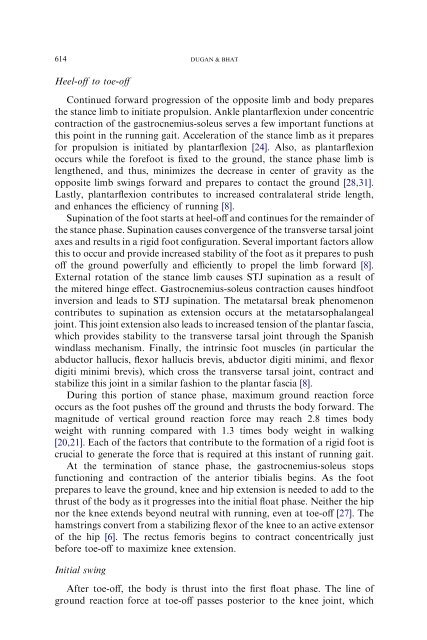Biomechanics and Analysis of Running Gait
Analysis of running
Analysis of running
You also want an ePaper? Increase the reach of your titles
YUMPU automatically turns print PDFs into web optimized ePapers that Google loves.
614 DUGAN & BHATHeel-<strong>of</strong>f to toe-<strong>of</strong>fContinued forward progression <strong>of</strong> the opposite limb <strong>and</strong> body preparesthe stance limb to initiate propulsion. Ankle plantarflexion under concentriccontraction <strong>of</strong> the gastrocnemius-soleus serves a few important functions atthis point in the running gait. Acceleration <strong>of</strong> the stance limb as it preparesfor propulsion is initiated by plantarflexion [24]. Also, as plantarflexionoccurs while the forefoot is fixed to the ground, the stance phase limb islengthened, <strong>and</strong> thus, minimizes the decrease in center <strong>of</strong> gravity as theopposite limb swings forward <strong>and</strong> prepares to contact the ground [28,31].Lastly, plantarflexion contributes to increased contralateral stride length,<strong>and</strong> enhances the efficiency <strong>of</strong> running [8].Supination <strong>of</strong> the foot starts at heel-<strong>of</strong>f <strong>and</strong> continues for the remainder <strong>of</strong>the stance phase. Supination causes convergence <strong>of</strong> the transverse tarsal jointaxes <strong>and</strong> results in a rigid foot configuration. Several important factors allowthis to occur <strong>and</strong> provide increased stability <strong>of</strong> the foot as it prepares to push<strong>of</strong>f the ground powerfully <strong>and</strong> efficiently to propel the limb forward [8].External rotation <strong>of</strong> the stance limb causes STJ supination as a result <strong>of</strong>the mitered hinge effect. Gastrocnemius-soleus contraction causes hindfootinversion <strong>and</strong> leads to STJ supination. The metatarsal break phenomenoncontributes to supination as extension occurs at the metatarsophalangealjoint. This joint extension also leads to increased tension <strong>of</strong> the plantar fascia,which provides stability to the transverse tarsal joint through the Spanishwindlass mechanism. Finally, the intrinsic foot muscles (in particular theabductor hallucis, flexor hallucis brevis, abductor digiti minimi, <strong>and</strong> flexordigiti minimi brevis), which cross the transverse tarsal joint, contract <strong>and</strong>stabilize this joint in a similar fashion to the plantar fascia [8].During this portion <strong>of</strong> stance phase, maximum ground reaction forceoccurs as the foot pushes <strong>of</strong>f the ground <strong>and</strong> thrusts the body forward. Themagnitude <strong>of</strong> vertical ground reaction force may reach 2.8 times bodyweight with running compared with 1.3 times body weight in walking[20,21]. Each <strong>of</strong> the factors that contribute to the formation <strong>of</strong> a rigid foot iscrucial to generate the force that is required at this instant <strong>of</strong> running gait.At the termination <strong>of</strong> stance phase, the gastrocnemius-soleus stopsfunctioning <strong>and</strong> contraction <strong>of</strong> the anterior tibialis begins. As the footprepares to leave the ground, knee <strong>and</strong> hip extension is needed to add to thethrust <strong>of</strong> the body as it progresses into the initial float phase. Neither the hipnor the knee extends beyond neutral with running, even at toe-<strong>of</strong>f [27]. Thehamstrings convert from a stabilizing flexor <strong>of</strong> the knee to an active extensor<strong>of</strong> the hip [6]. The rectus femoris begins to contract concentrically justbefore toe-<strong>of</strong>f to maximize knee extension.Initial swingAfter toe-<strong>of</strong>f, the body is thrust into the first float phase. The line <strong>of</strong>ground reaction force at toe-<strong>of</strong>f passes posterior to the knee joint, which


